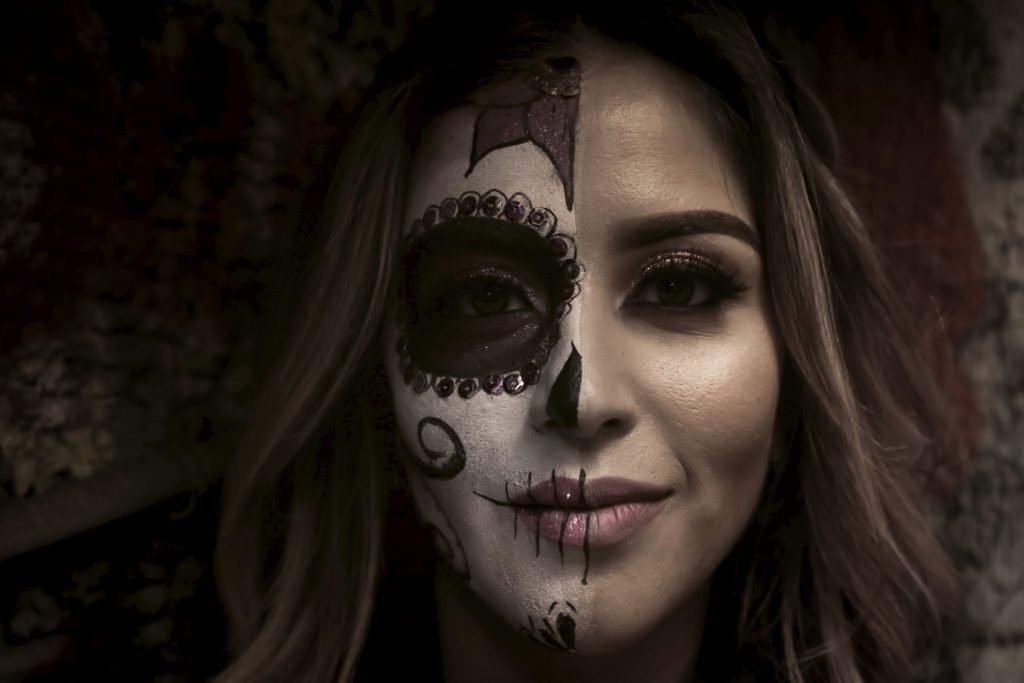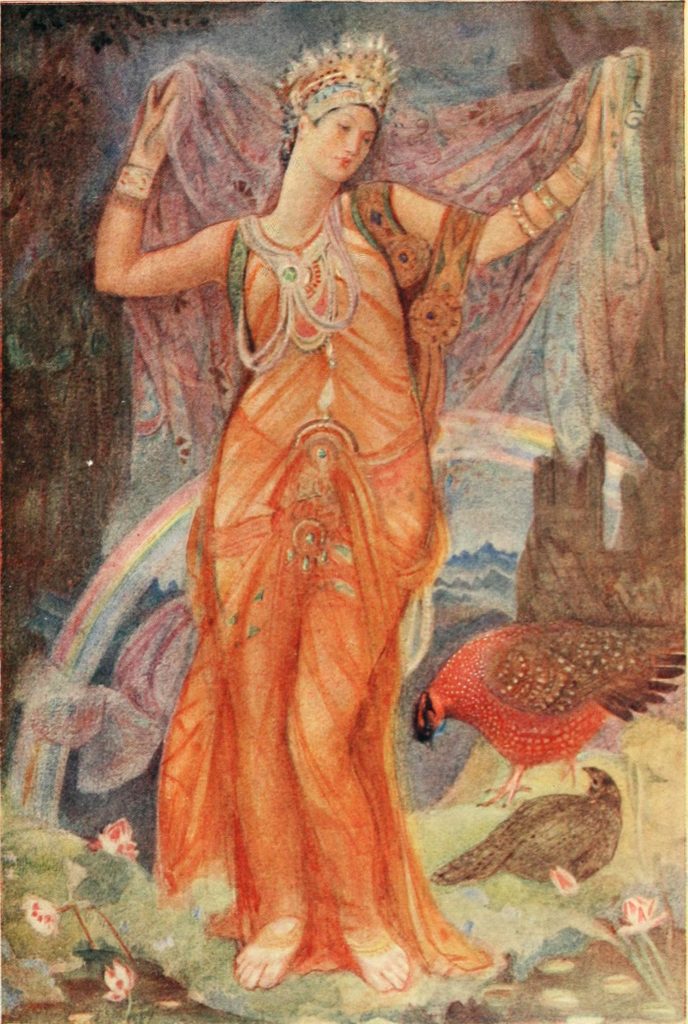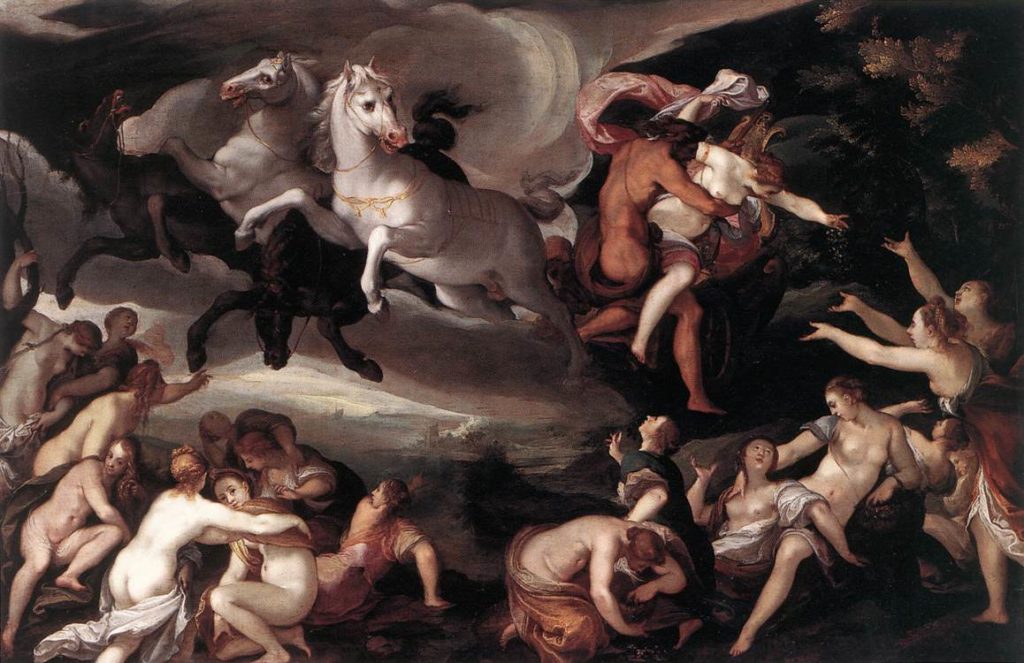
Venus is associated with love, beauty and harmony, but in aspect to Pluto, Venus shows she is not all sweetness and light, and is likely to reveal her inner intensity and steel.
Venus Trine/Sextile Pluto
Venus represents pure, free-flowing love and creativity. Pluto, lord of the underworld brings intensity, power and depth to any planet he influences. Venus in aspect to Pluto desires to embrace and scrutinise the mysteries of life, love and pleasure. A yearning for love (and sex) that merges mind, body and soul.
A trine is considered a positive aspect, and indicates ease and flow in the relationship between planets, no effort is needed to manifest the energies involved. A sextile is also quite harmonious, it encourages and brings the opportunity to manifest the energies, but they require more work to produce results.
With Venus trine/sextile Pluto, natives are likely to be in touch with an inner depth of wisdom and understanding about the light, and the dark side, of emotions, love, power and status. Life could be tinged with themes involving control, power, secrets, obsession, manipulation, betrayal, revenge and death – but also to one level or another an ease and comfort with this.
Venus/Pluto brings emotional courage, a willingness to step into the dark to explore and take responsibility for their own emotional energy and behaviour, equally this provides them insight into, and understanding of, the motivations of others.
Venus/Pluto can potentially bestow beauty, magnetic looks alongside captivating charm. An ease appreciating and discerning what’s aesthetically pleasing and stylish, potentially accompanied by striking artistic and creative talent. Creative work and expression is likely to be bold, deep and moving – nothing superficial here.
Pursuing and handling power, status and wealth may come easily, and there is also a possibility of being born into it or attaining it through marriage/love. In relationships natives are inclined to be loyal and devoted – with a good chance of attaining rewarding, fulfilling connections with others.
Anything Venus/Pluto is passionate about is likely to be sought out and followed with discipline and dedication, even a hint of obsession. Natives could be naturally highly intuitive, and possess a fascination with what’s hidden in the shadows. A need to seek out and explore these realms means they may venture (deeply) into matters of spirituality and the occult. Venus/Pluto is liable to enjoy soul-searching, anything that leads to spiritual evolution and growth.
VENUS TRINE PLUTO NATIVES
Baba Vanga 0 00′ Swami Sivananda 0 09′ Vanessa Redgrave 0 09′ Gisele Bundchen 0 19′ Samael Aun Weor 0 20′ Jimi Hendrix 0 25′ Adam Levine 0 28′ Amal Clooney 0 30′ Kate Moss 0 52′ Betty Ford 0 53′ Jimmy Page 0 58′ The Queen, Elizabeth II 1 14′ Lewis Hamilton 1 18′ Anne Boleyn 1 23′ Boy George 1 28′ Caitlyn Jenner 2 20′ Bjork 2 22′ Peaches Geldof 2 40′ Amanda Knox 2 47′ Tori Spelling 3 02′ Venus Williams 3 44′ Elizabeth I of England 3 49′ John F Kennedy Jr 3 49′ Bob Marley 4 56′
VENUS SEXTILE PLUTO NATIVES
Vanessa Paradis 0 06 Charles, Prince of Wales 0 10′ Sylvia Plath 0 11′ Meg Ryan 0 32′ Bill Clinton 0 44′ Felicity Huffman 0 49′ Ivanka Trump 0 54′ Teri Hatcher 1 10′ Nostradamus 1 14′ Henry Cornelius Agrippa 1 49′ Jerry Hall 1 53′ Nicole Scherzinger 2 01′ Anthony Bourdain 2 06′ Fred Astaire 2 14′ Jay-Z 2 18′ Mayer Amschel Rothschild 2 20′ Duke of Edinburgh 2 21′ Roman Polanski 2 23′ Kelly Brook 2 32′ Johannes Kepler 3 22′ Cheryl Cole 3 48′
Mythology
The signs and planets all have rich and varied mythological stories spun around them. Exploring mythology, using the tales as tools, helps enhance understanding and insight into the astrology.
The earliest astrological records come from Mesopotamia, which encompassed Babylon. In Babylonian mythology – predating Greek myth by quite a number of centuries – we find Venus linked with the goddess Ishtar, a goddess of love and war. Ishtar was beautiful, sensual, but if her temper was ignited, fiery and vengeful.
The origins of of Ishtar lie in Sumerian myth, and the goddess Inanna.
“The Descent of Inanna” into the underworld is one of the oldest stories in the world, written in the form of a poem. Inanna is the Queen of Heaven, who “set her mind on the great below”. Inanna, “abandoned heaven, abandoned earth, and descended to the underworld”.
Inanna descended into the underworld to visit her recently widowed sister, Queen of the Underworld, Ereshkigal – the female incarnation of Pluto – to witness the funeral of Ereshkigal’s husband, Gugalanna, the Bull of Heaven. Inanna is seeking to enhance her wisdom or extend her power into the realm of the underworld.
Inanna had prepared for the journey by adorning herself with jewellery and clothes that denoted her status and power. As a precaution, Inanna also instructs her faithful servant Ninshubur to get help if she does not return within three days.
At each of the seven gates to the underworld, Inanna is gradually stripped of her regalia. Everything that she used to define her identity, until she is “Naked and bowed low” when she meets the Queen of the Underworld.
Ereshkigal was furious at Inanna visiting her realm. “Inanna was turned into a corpse, A piece of rotting meat, And was hung from a hook on the wall.”
Ninshubar goes first to Enhil, god of air, then Nanna, the Moon-god for help, both refuse. Finally she visits Enki, god of water and wisdom, who creates two creatures – neither male or female – from the dirt under his fingernails. Enki provides them with the food and water of life, and instructs them to go to the underworld. Enki tells them that Ereshkigal will be moaning and crying, and that they are to commiserate and sympathise with her.
Ereshkigal is so grateful for empathy that she hands over Inanna’s corpse. Inanna is revived and restored to life, but in order to ascend from the underworld she has to provide someone to take her place.
Inanna will not hand over anyone who has mourned for her. Finally she comes upon her husband, Dumzi, who obviously was not grieving for her, but rather enjoying his time on her throne. He “was dressed in his shining me garments. He sat on his magnificent throne; (he did not move)”.
Dumzi takes Inanna’s place in the underworld. Although Inanna has revenge, she experiences great pain and mourns the loss of her husband. Finally, she can fully understand Ereshkigal’s rage and sorrow. Inanna sought, and gained, wisdom of loss, death and despair,
One version of the later Babylonian myth – Ishtar’s Descent” – has Ishtar going to rescue her lover Tammuz. In this tale, the gods of heaven ordered Ishtar and Tammuz to be released, as during Ishtar’s absence all earthly fertility ceased. Both Ishtar and Tammuz were associated with fertility, vegetation and crops – as Mother Earth and the Sun – explaining the change of seasons, and the reason Tammuz spent half the year in the Underworld.

The tale of Ishtar and Tammuz has similarities to the Greek myth of Demeter (Ceres) and her daughter Persephone, who was abducted and whipped away to the underworld by Pluto. The myth of Aphrodite (Venus) and Adonis can also be traced to Ishtar and Tammuz.
Sumerian Inanna and Babylonian Ishtar are the earliest incarnations of Venus. In their time both were very important deities. Venus is the third brightest object in the sky after the Sun and Moon, meaning Venus was highly conspicuous to the Babylonian astronomer/astrologers; who closely observed and recorded the movement of the planets in the heavens – with incredible, and astonishing accuracy, considering they had no telescopes or calculators. The astrologers then interpreted, and made predictions from the omens in the sky – about the harvest, war, peace and the fate of the King.
The descent myths also relate to Venus being either a morning or an evening star, her disappearance and reappearance. Inanna & Ishtar are far more complex and potent than Greek Aphrodite and Roman Venus – associated with war, power, politics, wisdom, sex, fertility, the crop cycle, as well as – rather than primarily – love, beauty and harmony.
TAROT
VENUS ~The Empress – TAURUS ~ The Hierophant – LIBRA ~ Justice
PLUTO ~ Judgement – SCORPIO ~ Death
Top Image from Unsplash by Tony Hernandez
Myths and Legends of Babylonia and Assyria -1916-jpg – from Wikimedia Commons
The Rape of Proserpina: Heintz-Joseph-the-Elder – from Wikimedia Commons
References
Astrology in Ancient Mesopotamia by Michael Baigent
Mysteries Of The Dark Moon by Demetra George
Inanna Queen of Heaven and Earth, Her Stories And Hymns From Sumer by Diane Wolkstein and Samuel Noah Kramer